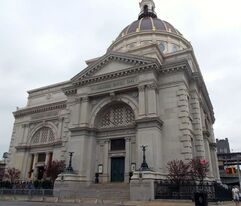Williamsburg tour
Once an industrial power and immigrant center, Brooklyn's Williamsburg neighborhood is known for food, shopping, hipsters, Hasids, and new construction. But it's far more than that.
 Former Williamsburgh Savings Bank, now Weylin event space Former Williamsburgh Savings Bank, now Weylin event space
Williamsburg may be the most interesting neighborhood--or district--in the city. Once a resort in the 19th century, it became an industrial power, based on the sugar industry and other manufacturing concerns, with its own main street and banks.
When the Williamsburg Bridge opened in 1903 century, Williamsburg became an extension of the Lower East Side ghetto, a densely populated tenement area, home to Eastern European Jews, Italians, and Poles. After World War II and the building of the Brooklyn Queens Expressway, the neighborhood lost industry and many longtime residents. New arrivals included Hasidic Jews who survived the Holocaust and Puerto Ricans moving for factory work. Williamsburg struggled for decades, but was buoyed by reinvestment by the city (under Mayor Ed Koch), via nonprofit neighborhood groups, to stabilize buildings, then an influx of artists and others seeking space near Manhattan. That move begat bars, restaurants, night spots, galleries, and a waves of gentrification. A 2004 rezoning emphasized market-rate housing, pushed by the mayor's office and floating on very generous tax breaks. New buildings sprouted. That makes for an astonishing contrast between the 1980s and now, as documented by various photographers and filmmakers. The artists are mostly gone, as are many of the Latinos. See Williamsburg, Brooklyn on a tourNow Williamsburg is one of the hottest neighborhoods in New York, a beacon to young people throughout the world and a weary cliche to some others. There's dramatic change--especially high-rises at the waterfront--but also many ties to the past.
Our route usually includes the Hasidic enclave of South Williamsburg, home to the neighborhood's historic library and mansions since converted to yeshivas, mainly for the Satmar Hasidim. We'll also see the historic Broadway corridor near the Williamsburg Bridge, home to former banks and the famed Peter Luger steakhouse. We'll traverse the long-gritty but steadily changing Southside, still with a significant Hispanic presence, and see plans some astonishing new planned development. We'll proceed to the Northside, home to an astonishing array of restaurants, bars, and shopping, as well as new and reclaimed buildings, some far more impressive than others. Yes, there are snacking opportunities, as well as many restaurants you could visit before or after our tour. Note that the typical 2.5-hour tour only covers particular slices of Williamsburg. We could easily extend it by an hour or two, deeper into Williamsburg--without going to adjacent neighborhoods. |
Distance from Midtown Manhattan: 25-30 minutes by subway, also accessible by ferry from Pier 11/East 34th Street
Cost: see fees here Basic tour length: 2.5-3+ hours (see fees) Starting place: Near J train, L train, East River Ferry Ending place: Near J train, L train, East River Ferry Highlights: Industrial history, ethnic diversity, art, gentrification, shopping Before/after tour: Many food options, including Brooklyn Brewery. Snacks during tour: chocolate, ice cream, cup cakes, pastries, coffee Variations: Saturday tour omits Hasidic zone, but allows more time for other areas, including Central Williamsburg Potential tour extensions with me: Greenpoint, East Williamsburg/Bushwick, DUMBO (via NYC Ferry), Long Island City (via NYC Ferry) , Lower East Side, Brooklyn 101 (via NYC Ferry) Why I like leading this tour: Many people think they know something about Williamsburg. I'm confident this will offer a lot more grounding and complexity. |